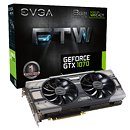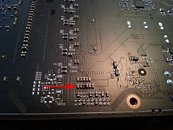Monday, October 24th 2016

EVGA GTX 1070/1080 Overheating Issues - Company Says Thermal Pads A Solution
After users' reports (and Tom's Hardware.de testing) of EVGA FTW 1080 and 1070 cards displaying black screen issues, and sometimes even sparking and dying altogether, even at stock voltage, the company is now moving towards fixing the issue.
Apparently, the issue stems from the absence of any thermal pads over the VRM area of the FTW line of cards, which prompts higher operating temperatures. Some users were reporting heat transfer in such quantities that even the GDDR5X memory chips on the cards were being heated at 107 ºC, significantly over their rated operating temperatures of (0°C ≤ TC ≤ +95°C).In a blog post on EVGA's forums, a company representative issued the following message:
"The test used in the referenced review from Toms Hardware (Germany) is running under Furmark, an extreme usage case, as most overclockers know. We believe this is a good approach to have some idea about the graphics card limit, and the thermal performance under the worst case scenario. EVGA has performed a similar qualification test during the design process, at a higher ambient temperature (30C in chamber) with a thermal coupler probe directly contacting the key components and after the Toms Hardware (Germany) review, we have retested this again. The results in both tests show the temperature of PWM and memory is within the spec tolerance under the same stress test, and is working as originally designed with no issues.
With this being said, EVGA understands that lower temperatures are preferred by reviewers and customers.
During our recent testing, we have applied additional thermal pads between the backplate and the PCB and between the baseplate and the heatsink fins, with the results shown below. We will offer these optional thermal pads free of charge to EVGA owners who want to have a lower temperature. These thermal pads will be ready soon; and customers can request them on Monday, October 24th, 2016. Also, we will work with Toms Hardware to do a retest."
EVGA stresses that according to their own internal testing, no overheating issues are present in the card by using it as is (i.e., without the thermal pads), and that there won't exist any long term effects on using the cards such as they are. The company reiterates that their offer stands only inasmuch as some of EVGA's users want lower temperatures specifically on the referred cards' VRM and memory, with the usage of the thermal pads not being required to achieve normal operation. In a statement, the company has also attributed the black screen issues towards an "out of spec On Semiconductor component" that affected only 3-4% of EVGA's GTX 1080 FTW/HYBRID, with these issues "not [being] related to temperatures in any way" having been fixed as of September 1st, with the company having already sent replacements where applicable.
The thermal pads will be provided to anyone with a GTX 1080 or GTX 1070 with an ACX cooler and a backplate, with other graphics card models from EVGA's models also being considered for the offer. While EVGA is surely going about the problem in the correct manner, it still leaves to customers the responsibility of dismantling their EVGA cards and applying the thermal pads on their own. Bellow is an image posted by EVGA showing the temperature results of a GTX 1080 FTW with the thermal pad solution.
Source:
EVGA Blogs
Apparently, the issue stems from the absence of any thermal pads over the VRM area of the FTW line of cards, which prompts higher operating temperatures. Some users were reporting heat transfer in such quantities that even the GDDR5X memory chips on the cards were being heated at 107 ºC, significantly over their rated operating temperatures of (0°C ≤ TC ≤ +95°C).In a blog post on EVGA's forums, a company representative issued the following message:
"The test used in the referenced review from Toms Hardware (Germany) is running under Furmark, an extreme usage case, as most overclockers know. We believe this is a good approach to have some idea about the graphics card limit, and the thermal performance under the worst case scenario. EVGA has performed a similar qualification test during the design process, at a higher ambient temperature (30C in chamber) with a thermal coupler probe directly contacting the key components and after the Toms Hardware (Germany) review, we have retested this again. The results in both tests show the temperature of PWM and memory is within the spec tolerance under the same stress test, and is working as originally designed with no issues.
With this being said, EVGA understands that lower temperatures are preferred by reviewers and customers.
During our recent testing, we have applied additional thermal pads between the backplate and the PCB and between the baseplate and the heatsink fins, with the results shown below. We will offer these optional thermal pads free of charge to EVGA owners who want to have a lower temperature. These thermal pads will be ready soon; and customers can request them on Monday, October 24th, 2016. Also, we will work with Toms Hardware to do a retest."
EVGA stresses that according to their own internal testing, no overheating issues are present in the card by using it as is (i.e., without the thermal pads), and that there won't exist any long term effects on using the cards such as they are. The company reiterates that their offer stands only inasmuch as some of EVGA's users want lower temperatures specifically on the referred cards' VRM and memory, with the usage of the thermal pads not being required to achieve normal operation. In a statement, the company has also attributed the black screen issues towards an "out of spec On Semiconductor component" that affected only 3-4% of EVGA's GTX 1080 FTW/HYBRID, with these issues "not [being] related to temperatures in any way" having been fixed as of September 1st, with the company having already sent replacements where applicable.
The thermal pads will be provided to anyone with a GTX 1080 or GTX 1070 with an ACX cooler and a backplate, with other graphics card models from EVGA's models also being considered for the offer. While EVGA is surely going about the problem in the correct manner, it still leaves to customers the responsibility of dismantling their EVGA cards and applying the thermal pads on their own. Bellow is an image posted by EVGA showing the temperature results of a GTX 1080 FTW with the thermal pad solution.




82 Comments on EVGA GTX 1070/1080 Overheating Issues - Company Says Thermal Pads A Solution
This news post consist of blown capacitor element on the board. I call that rubbish and and a single accident. Such serious damage as blown single element occur rarely... Often from overvoltage(bad PSU spike). That is not the cause for black screens and is completely a different thing thrown into this article and you mindlesly chew it on without considering facts.
The vram overheating especially using furmark? That's also something else.
This looks like some speculation to gather clicks, the real issue is somewhere else.
I always wondered if I should've waited a couple of more days; now I know the answer.
The issue arises not directly with the VRM temps, but the temps of the two GDDR5(X) modules next to the VRM section. Those are rated for 95 C and exceed that temperature. This results in black screen/artifacting even at stock.
The reported issues arise even at stock clocks for those who have issues. The only confirmed issues with hot GDDR5X are on the FTW 1080. The 1070 has a similar VRM section and cooler design, but a lower TDP.
I'm still considering whether or not I'll return my card. I've sent EVGA an RMA request to have them apply the solution themselves. I'm not burning myself on this one, I can still return the card to the seller. Even if my card runs a lot cooler than the ones in the reports... I've never seen temps go past 65 C in game, with 122% PT and maxed out OC, but still I am almost convinced the lifespan of the card is lower than it should be.
The lack of a clear response from EVGA prompted my RMA 'test' request. If they are unwilling to apply the correct solution to my card, I'm sending it back. Not taking any risk with this heavily overpriced piece of kit - even if I have an 'above average' core OC :)
Shame really. I hate this hassle.
People bought these cards expecting that they were fully furnished. That's what the reviews led them to believe. If they were going to "normally use" these cards they would have just bought a dell with a "4Gb Nvidia graphics card" inside.
EVGA has yet to give a clear statement and instructions regarding the offered solution and they tell me my card 'has no issues'. On my replied question as to the impact on longevity of the card, they responded by suggesting I'd better buy into their 5 year extended warranty plan. I'm not even going to dignify that with a response because I just can't be arsed to - EVGA customer service is on the ball, but clearly this fuckup was concluded to cost them waaay too much money because in essence, EVERY card is affected and they want to keep that fact as low-key as possible. Even though from a business perspective I fully understand this, for me personally it's something I do not accept. The vast majority of users won't be pushing 99% utilization with an OC from day one, but increased degradation is the only possible result of this cooling design. This 'fact' was not confirmed or denied - in other words, nuff said.
The fact they try to push me into extended warranty says enough. That's as much as implicitly stating it will break down eventually, and most likely just after 3 years have passed.
The bottom line of this story is: avoid the FTW 10xx or demand that it comes with the thermal pad fix (EVGA confirmed they will incorporate that into the manufacturing process now) AND SAMSUNG VRAM. The Micron memory clocks consistently lower. Lesson learned ^^
This also still isn't a real problem the faster people realize furmark is dumb the better. Let it kill their damn cards. Consider it darwinism
Furmark simply stabilizes the power draw at max while benches and games are more spiky in behaviour. Nothing else. Furmark is therefore STILL a good stress bench, and will immediately show shoddy cooling instead of normal benchmarks that need many runs to give you a glimpse. Even EVGA agreed on that, btw.
That's darwin for ya right there... I would say apply Darwinism to the FTW cooling solution, and the only conclusion is that it cannot keep up with the rest of the product and needs replacing. ACX 3.0 lost the race.
It is a power leach nothing compares even folding or bitcoin mining on the cards.
EVGA is providing a solution. If you don't like their solution don't buy their product. They are however the number one selling cards in the states...
Another note open test benches aren't the best for everything. Unless you have a GPU fan specifically blowing across the backplate of the card most standard cases would keep the RAM and VRM cooler.
The PSA regarding those thermal pads is a nice little spin on the issue which gives you the idea they are being very nice to all FTW customers, but this is damage control and nothing else. You even get to apply them yourself, how awesome is that?! /sarcasm
How many cards have 'shoddy cooling' to being with? I mean most have 'shoddy cooling' when you run Furmark........... oh wait, it throttles modern cards back at stock speeds... my fault.........